![]()

![]() 1-bit image - A digital image with one bit allocated for the storage of each pixel, meaning 2 different colors are possible —
1-bit image - A digital image with one bit allocated for the storage of each pixel, meaning 2 different colors are possible — black and white.

![]() 2-bit image - A digital image with two bits allocated for the storage of each pixel, meaning four monochromatic colors are possible — a
2-bit image - A digital image with two bits allocated for the storage of each pixel, meaning four monochromatic colors are possible — a gray scale (or value scale) of four values.

![]() 3-bit image - A digital image with eight bits allocated for the storage of each pixel, meaning eight monochromatic colors are possible — a
3-bit image - A digital image with eight bits allocated for the storage of each pixel, meaning eight monochromatic colors are possible — a gray scale (or value scale) of eight values.

![]() 4-bit image - A digital image with two bits allocated for the storage of each pixel, meaning eight monochromatic colors are possible — a
4-bit image - A digital image with two bits allocated for the storage of each pixel, meaning eight monochromatic colors are possible — a gray scale (or value scale) of sixteen values.
![]()
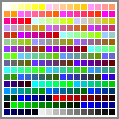
![]()
8-bit image - A digital
image with eight bits allocated for the storage of each pixel, meaning 256 different colors are possible. An example is Apple's Macintosh computer's palette (color look-up table [CLUT]) of 256 colors.
12-bit image - A digital image with twelve bits allocated for the storage of each pixel, meaning 4096 different colors are possible — a palette (color look-up table [CLUT]) of 4096 colors.

![]()
16-bit image - A digital image with sixteen bits allocated for the storage of each pixel, meaning 32,768 different colors are possible. An example is GraphicConverter's palette (color look-up table [CLUT]) of 32,768 different colors. Also see gradation and value scale.
24-bit image - A digital image with twenty-four bits allocated for the storage of each pixel, meaning 16,770,000 or 16.8 million colors are possible.
32-bit image - A digital image with thirty-two bits allocated for the storage of each pixel, meaning about 4 billion colors are possible. [Will that be enough for you?!]
A - When found on a tube or other container of paint, indicates the standard degree of color permanence.
|
letter code |
degree of color permanence |
|
AA |
highest |
|
A |
standard |
|
B |
less than standard, though fairly durable |
|
C |
fugitive |
Also see AA, archival image, B, C, and fugitive colors.
Å - Abbreviation for angstrom.
AA - When found on a tube or other container of paint, indicates the highest degree of color permanence. Also see A, archival image, B, and C.
abacus - In architecture, a flat slab on top of a capital, beneath an architrave. Also called an impost block.
Example:
An abacus as part of a schematic diagram of the Doric order.
Also see capital, column, classical orders, cornice, Corinthian, Doric, echinus, entablature, frieze, Ionic, metope, orders, shaft, and stylobate.
abbozzo - In painting, blocking in — the first sketching done on the canvas, and also the first underpainting. In sculpture, a mass of material that has been carved or manipulated into a rough form of the ultimate work. Italian for "sketch."
ABC art - See Minimalism.
abecedarian - Having to do with the alphabet, or arranged in alphabetical order. Sometimes spelled ABCDarian. Among other ways of ordering things, it should be compared with numerical and chronological ordering, periodicity, taxonomy, etc.
Also see chronology, rhythm, and sequence.
ablaq - Islamic ornament, generally in masonry, often inlaid marble, which is black and white. Persian, literally: piebald.
Example:![]()

![]()
Egypt, Mosque
of Barquq, ablaq panels, above an entrance doorway, black
and white marbles.
Aboriginal art - Art made by the aboriginal peoples of Australia — native to Australia (before Europeans arrived).
Example:
![]()

Victor Jupurrula Ross (Yuendumu, Western Desert, Northern Territory, Australia, contemporary), Yarla Jukurrpa ('Bush Potato Dreaming'), acrylic paint on canvas, 1987, British Museum, London.
Also see Australian art, ethnic, folk art, Heidelberg school, and primitive.
abrade - See abrasive.
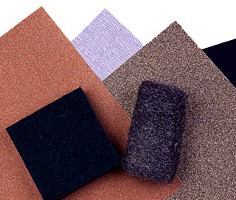
abrade, abrasion, abrasive - To abrade is to wear away by friction, rubbing. Abrasion is the action or technique of wearing away a surface by friction, and can 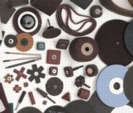 be a means of shaping solid forms. An abrasive is any substance which wears down a surface
by rubbing against it. Abrasives are available in many forms,
including powders, compounds, papers, wheels or disks, brushes, belts, and
more, each most appropriate for certain applications. Sandpapers
and grinding disks and wheels, for instance, have abrasive surfaces
used to wear down surfaces, or to smooth out rough ones.
be a means of shaping solid forms. An abrasive is any substance which wears down a surface
by rubbing against it. Abrasives are available in many forms,
including powders, compounds, papers, wheels or disks, brushes, belts, and
more, each most appropriate for certain applications. Sandpapers
and grinding disks and wheels, for instance, have abrasive surfaces
used to wear down surfaces, or to smooth out rough ones.  To wear
down by rubbing is to abrade.
To wear
down by rubbing is to abrade.
Also see Carborundum, carving, corundum, emery, eraser, erasure, finish, glass, mark, metal, polish, pumice, rottenstone, rouge, and wood.
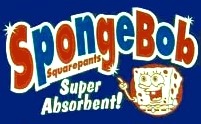
absorbent, absorbent ground - A material is absorbent when it can soak up liquids. Towels, rags, and sponges are common examples, often used to blot, clean up, apply and spread colors, etc. An absorbent ground is a ground or coating on a surface that can absorb the liquid from paint applied to it.
Also see absorption, gesso, canvas, paper, stain and stain removal, and vehicle.
absorption - Refers to the light absorbing behavior of some surfaces — various characteristics determine the degree to which surfaces absorb certain colors. The light which is absorbed is converted to heat, while light not absorbed is either transmitted (by transparency or translucent surfaces) or reflected (by opaque surfaces). Not to be confused with adsorption.
Also see additive, angle of incidence, reflected color, and reflection.
Abstract Expressionism or abstract expressionism
Abstraction-Creation Group - An international school of painters and sculptors of the 1930s, who typically employed geometric shapes and forms. Piet Mondrian was the most prominent figure in the Abstract-Creation Group.
Also see Bauhaus and De Stijl.
![]()

![]() absurd - Ridiculously incongruous
or unreasonable, because of a flaw in logic. Also, pertaining
to the view that there is no order
or value in human life or in the universe — a condition in which
human beings exist in a meaningless, irrational world in which
people's lives have no purpose or meaning.
absurd - Ridiculously incongruous
or unreasonable, because of a flaw in logic. Also, pertaining
to the view that there is no order
or value in human life or in the universe — a condition in which
human beings exist in a meaningless, irrational world in which
people's lives have no purpose or meaning.
Also see consistency, existentialism, Fluxus, harmony, incongruity, juxtaposition, meaning, and Rube Goldberg.
academic - Having to do with the affairs or ways of academies, or works of art that were done according to established, traditional ways.
Also see academician, academy, bad art, brummagem, kitsch, secession, and teacher.
academician - Either an elected member of an academy, or an artist who follows the principles of the traditional and conservative academic tradition. Adolphe-William Bouguereau (French, 1825-1905) was an archetypal academician. Bouguereau was immensely successful and influential as an exponent of academic art, upholding traditional values and contriving to exclude avant-garde work from the Salon.
An example of his work:

Adolphe-William Bouguereau (French, 1825-1905),
Temptation, 1880, oil
on canvas, Minneapolis Institute
of Arts.
Also see American Academy of Arts and Letters (AAAL) and teacher.
academy - A learned group accepted as authoritative in its discipline (subject area), or a school in which art is taught. Originally the school of philosophy founded by Plato in the garden of Academe, a district in the vicinity of Athens. It was closed by the Byzantine emperor Justinian I, with the other pagan schools, in 529 CE. The term usually refers to a recognized society established for the promotion of one or more of the arts or sciences. The earliest such organization was the Museum of Alexandria, founded by Ptolemy Soter in the third century BCE. The first such academy following the classical era in Europe was the Florentine Academy of Design (Accademia di Designo), founded by Giorgio Vasari (1511-1574) in 1560. Michelangelo was elected an officer in 1563, one year before he died. Numerous academies flourished in Italy, France, Germany, Austria, and Britain during and since the Renaissance. By 1729 there were more than five hundred in Italy alone. Academies specifically for art instruction Among the several academies in France, the one concerned with the visual arts is the French Royal Academy of Painting and Sculpture, founded in 1648 by Colbert and King Louis XIV, and later known as the Académie des Beaux-Arts. Because the French academies dictated elaborate conventions and aesthetic doctrines for the manufacture of works of art, the term "academic" came to imply derivative rather than creative work. In England, the Royal Academy of Arts was established in 1768. Today it serves primarily as an art school and exhibition facility. The first art museum and art school in the U.S. was the Pennsylvania Academy of the Fine Arts, founded in 1805 by Charles Willson Peale (1741-1827). Because they've generally supported the aesthetic tastes of their elders, academies have often been the targets of innovators in the arts. An academy figure.
Also see academic, academician, academy figure, American Academy of Arts and Letters (AAAL), avant-garde, Salon, and teacher.
academy figure - Sometimes simply called an academy, an academic figure is a two-dimensionally drawn or painted figure of a nude model, about half-size, typically used for instruction and not considered a work of art at the time it was made. Such life drawing or painting studies, demonstrating skill in idealistic or realistic representation of human anatomy, became standard exercises in art schools (academies) from the sixteenth century until late in the nineteenth century.
Examples:

French Painter, about 1816, Study of a Nude Man, oil
on canvas, 31 3/4 x 25 1/4
inches (80.6 x 64.1 cm), Metropolitan Museum of Art, NY.

Ferdinand-Victor-Eugène Delacroix
(French, 1798-1863), Male Academy Figure, probably Polonais, standing,
1821, black, white, and sanguine
chalk (conté
crayon?), 17 5/8 x 22 3/4 inches (44.8 x 57.8 cm), private
collection. See Romanticism.
acanthus - The thorny leaf of an herb native to the Mediterranean region, the design of which has been used as a stylized motif throughout history. Of special note is its use in capitals of the Corinthian and composite order. It sometimes resembles the leaves of dandelion, thistle or artichoke plants, pinnately lobed basal leaves with spiny margins.
Examples:
![]()
Jordan, Palace in Mschatta, Rosette, mid-8th century, limestone
relief, Museum für Islamische
Kunst, Berlin. The design of this
of architectural
ornament incorporates elements
from ancient traditions,
and includes acanthus leaves and strings of pearls. See rosette.

![]()

John Ruskin (English, 1819-1900), Drawings of Acanthus, front and side
views, c. 1850.

Walter S. Arnold, Sculptor / Stone Carver
(contemporary, Chicago, IL), Mantelpiece, various stones, acanthus leaves
on each side.

David Reilly (American, contemporary), Acanthus Leaf, carved
wood relief,
c. 2003.
accelerator - A substance which speeds up a chemical change. An accelerator is added to oil paints to speed drying (also called a "drier"), and to polyester resin to promote curing. Alum is added to plaster as an accelerator to quicken its setting.
accent - In design, a distinctive feature or quality, such as a feature that accentuates or complements a decorative style. In line drawing, accenting lines is the gradual increase or decrease in the weight or thickness of lines as produced by a pencil or similar medium by the amount of pressure exerted on it while drawing. Accenting should not be confused with shading — the filling in of areas to represent shadow. Accenting refers only to lines used for the contours or outlines in the drawing of a subject. Generally, lines representing the nearest parts of a subject are accented most boldly. Also see compare, value, and gradation.
accession - A museum's act of acquiring an object so that the artwork becomes a part of its permanent collection, or, by extension, the acquiring of a piece by any collector. Or an object so acquired. Or the act of recording and processing an addition to a permanent collection. The opposite of accession is deaccession.
Also see collection, commodification, donation, and register.
accession number - A control number unique to an object, used to identify it among the other objects in that collection. It is part of the numbering system encompassing the permanent collection of an individual or an institution, and reflects the transaction making an object a part of that collection. An accession number is assigned based on the order in which it was acquired, not on its kind, and typically consists of the year of accession and the serial number within that year.
Also see catalogue number and museum.
accident, accidental - An accident is anything that happens by chance; uncontrolled occurrence. Although this may traditionally have negative connotations, an accident may be taken as a positive thing, as an oportunity. The word "accidental" is usually an adjective — aleatory — but it is sometimes used as a noun: an act interpreted as an accident occurring in the production of art is sometimes called "an accidental."
Quote:
Also see blot, cleaning art, clean up, Dada, stain and stain removal, and Surrealism.
accidental color - Color obtained by mixing on a painting's surface without conscious preliminary planning during the process of painting.
acculturation - Borrowing between cultures, or, the modifying of one person's or group's culture by contact with a different culture. Also, the process by which people acquire knowledge of the cultures in which they live.
accuracy - Correctness or exactness.
acetate - The common name for a type of strong, transparent or semi-transparent sheets of plastic, available in various thicknesses, and used in making covers for artwork, as the basis for photographic film, in color separation, in retouching, as cels in animated filmmaking; as a material for printing plates (see cellocut), and as an ingredient in some plastics, textile fibers, and lacquers. It should not be expected to be a permanent material.
Also see acetate color, Lucite, and Plexiglas.
acetate color - Opaque, waterproof paint which doesn't crawl or peel when used on acetate, glass, foil, or other extremely smooth surface. Acetate ink is an ink which can be applied either with a pen or a brush, and adheres to extremely smooth surfaces.
acetic acid - In graphics,
 a
liquid used to clean a plate just before the mordant
is applied.
a
liquid used to clean a plate just before the mordant
is applied.
Also see solvent.
acetone
- A volatile solvent,
commonly
 used with lacquers
and in paint-removers; also known as dimethyl ketone and 2-propanone.
It is soluble in water and alcohol. It is non-photochemically
reactive. One of its uses is to clean up epoxy
resins, polyester resins,
contact cement,
used with lacquers
and in paint-removers; also known as dimethyl ketone and 2-propanone.
It is soluble in water and alcohol. It is non-photochemically
reactive. One of its uses is to clean up epoxy
resins, polyester resins,
contact cement, fiberglass,
along with many inks and adhesives. Acetone is often used
in the cleaning and restoration of old paintings. It is slightly
toxic by skin contact and inhalation,
and it is highly flammable,
so carefully read cautioning labels on containers.
(pr. ASS-ə-tohn)
Also see art conservation and art restoration, and flammable.
acetylene - A colorless gas burned in combination with oxygen
for oxyacetylene welding.
Explosive, especially if used in welding with gauge
pressures over 15 psig (30 psig absolute). It has a garlic-like
odor. Tank sizes available are 10, 40, 75, 100, and 300 cubic
feet.
(pr. ə-SE-tə-leen)
Also see arc welding, argon, carbon dioxide, flammable, helium, hydrogen, nitrogen, and oxygen.
achieve, achievement - To achieve is to accomplish; to perform with success; to attain with effort or despite difficulty. Achievement is either the act of accomplishing or the thing accomplished. Achievement is especially the successful performance that reaches or exceeds a standard level.
A distinction between effort and achievement is noteworthy: effort is trying which may or may not result in success, while achievement is effort resulting in success. In other words, effort is of tremendous importance, but unless (or until) effort results in meeting goals, it does not met the criterion of "achievement." In an educational setting, the goals of assignments are set by educators (as part of a larger community) to be observable objectives. In a graphic design environment, goals may tied to sets of clients' specifications. In the fine arts, artists' achievements may be gauged by gallery sales and the judgments of viewers (especially of art critics, art historians, museums, and posterity). In each of these and in all art arenas, as in life's endeavors of every kind, the most fundamental gauge of achievement is ultimately one's measure of personal satisfaction.
The reception of praise, awards, or cash payments should not be confused with achievements (unless those have been the principal motivating factors, which would tend to devalue them), although these things recognize achievements. Renown, whether fame or notoriety, is another indicator of achievement, potentially both helpful and problematic. Historically, the works for which artists first become famous, have persistently influenced how later works are received. So, although renown may be achieved, what you wish to be renowned for is more worthy of your attention than the striving for renown itself. Vandals and forgers may become famous, after all, but are those reputations anyone needs?!
In heraldry, a coat of arms is sometimes called a "complete achievement."
Quotes:
Also see advocacy, artistic temperament, art therapy, attitude, choose, creativity, death, effort, enthusiasm, evaluation, genius, Individualized Education Program (IEP), inspiration, monument, motivation, multiple intelligence theory, obsession, perfection, posterity, and talent.
achromatic - Color having no chroma — black, white and grays made by mixing black and white. All other colors employ chromatic pigments.
(pr. AY-crow-MA-təck)
Also see 1-bit image, 2-bit image, 3-bit image, 4-bit image, 8-bit image, analogous, black and white, color scheme, complementary, gray scale, grisaille, monochromatic, neutral, optical mixing, split complementary, triadic (three), value, and value scale.
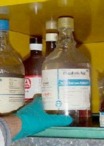
acid - Any of a large class of substances capable of
reacting with 
 and
dissolving certain metals
into salts, and of reacting with bases or alkalis to form salts.
Acids can weaken cellulose in papers, cardboards, and textiles,
eventually making them brittle. Acids are sometimes introduced
in the manufacture of certain
materials. They can also
be introduced by migration from other
materials or from atmospheric pollution. Acids and acidic materials
are used in various processes
or techniques in making art, and they are considered destructive to many works by those
concerned with art conservation.
and
dissolving certain metals
into salts, and of reacting with bases or alkalis to form salts.
Acids can weaken cellulose in papers, cardboards, and textiles,
eventually making them brittle. Acids are sometimes introduced
in the manufacture of certain
materials. They can also
be introduced by migration from other
materials or from atmospheric pollution. Acids and acidic materials
are used in various processes
or techniques in making art, and they are considered destructive to many works by those
concerned with art conservation.
Also see acid bath, acid-free, acid migration, hazardous, pickle, and safety.
acid
bath - In etching, the mordant —
 either
an acid or a diluted acid — in which a printing plate
to be etched is placed.
either
an acid or a diluted acid — in which a printing plate
to be etched is placed.
Also see acetic acid, feather, and nitric acid.
acid free - A characteristic of inert materials; especially said of papers with a 7 pH, or very close to 7 pH. Below 6.5 pH or above 8.5 pH is not considered acid-free. Acid free materials are more permanent, less likely to experience acid migration — to discolor, or to deteriorate materials they are placed with over time. Works on paper, and the mats, mounts, etc. with which they are framed, are best acid free. This term is sometimes used incorrectly as a synonym for "alkaline" or "buffered." Such materials may be produced from virtually any cellulose fiber source (cotton and wood, among others), if measures are taken during manufacture to eliminate active acid from the pulp. However free of acid a paper or board may be immediately after its manufacture, over time the presence of residual chlorine from bleaching, aluminum sulfate from sizing, or pollutants in the atmosphere may lead to the formation of acid unless the paper or board has been buffered with an alkaline substance. The presence of alpha cellulose in paper or board is an indication of its stability or longevity. Non-cellulosic components of wood are believed to contribute to the degradation of paper and board.
Also see adhesives, archival image, art conservation, buffer, glassine, polypropylene, and storage.
acid migration - The transfer of an acid from an acidic material to a less acidic or pH neutral material, most often from one with which it is in contact. Since acid can cause certain materials, such as paper, and the mats, mounts, etc. with which they are framed, to discolor and to deteriorate, acid migration is one of the factors to be considered in planning the storage of various artifacts, especially textiles and works on paper, including books, pamphlets, museum records, etc.
Also see adhesives, archival image, art conservation, and buffer.
ACMI - An acronym for the Art & Craft Materials Institute.
acquisition - An object a collector or museum acquires (accessions) through gift, bequest, field expedition, or purchase. Or such an act of acquiring.
Also see registrar.
acrolith - An ancient Greek sculpture in which the head and arms and feet were made of marble or some other stone. Greek for "stone-ended." At first an acrolith was considered to be a wooden sculpture with marble extremities, and later, a limestone sculpture with such marble features. The adjectival form is acrolithic.
acropolis - The Greek word meaning "high city." Ancient Greek builders chose to erect their towns around fortified hills upon which their main temples were placed. The most famous acropolis is in Athens.
(pr. ə-KRAH-pə-ləs)
The Acropolis of Athens:
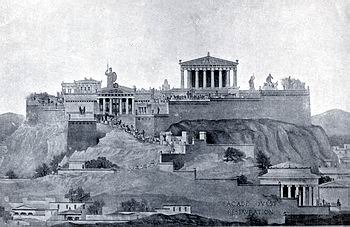
D'Espouy, Reconstruction of the Acropolis
of Athens, from Dr. D. Josef, Geschichte der Baukunst,
published in Leipzig, 1912.
Contemporary photograph of the Acropolis
(from Philopappos Hill), fifth century BCE,
Athens, Greece.
![]()

![]()
Contemporary aerial view of the Acropolis.
acroterion or acroterium - In classical architecture, a figure or ornament usually at the apex of the pediment. "Acroterion" is the Greek spelling. "Acroterium" is the Latin spelling.
(pr. AK-'ro-TEE-ri-əm)
Examples:

Greek, Apollo of Veii, an acterion sculpture from the Temple of Apollo,
Veii, c. 510 BCE,
terra cotta. See Apollo.
![]()

Greek, Acroterion from the Heraion, reconstructed
using original terra
cotta shards.

Greek, Corner Acroterion from the Heroon of Alyzia,
2nd century CE,
marble, Archaeological
Museum of Agrinion.

American, Philadelphia Museum of Art's Griffin Acroterion,
copper, PA. This acroterion is a
19th century work made in the classical
spirit in order to appropriately decorate
the museum's classical-style
architectural design.
Also see antefix.
acrylic flow improver - A medium used with acrylic paints designed to improve their flow without diminishing the strength of its color.
acrylics or acrylic plastics - A range of rigid, light weight, weather resistant plastics, used commonly in the form of sheets, films, rods, and fibers, as well as in their liquid state for casting, coating, and adhesives. Acrylics are notable among plastics for their resistance to chemical change, making them valuable for their permanence, and in art conservation. Acrylics may be made transparent, translucent, or opaque, and are available in a range of colors.
(pr. ə-CRI-ləks)
trade names for acrylics
|
trade name |
manufacturer, country |
| Courtelle ® (fiber) | Courtaulds, UK |
| Lucite ® | Du Pont, USA |
| Orion ® (fiber) | Du Pont, USA |
| Perspex ® | ICI, UK |
| PlexiGlas ® | Rohm & Hass, USA |
Also see cellocut, coated paper, fiberglass, and polyester resins.
actino- - A prefix (word beginning) meaning radial in form.
action pose - A figure's pose or attitude when it suggests movement.
action research - Disciplined inquiry-based research conducted by educational practitioners that follows a process of examining practices, implementing interventions, and evaluating results, leading to an improvement cycle benefiting students and practitioners. There are numerous synonyms, including: practitioner research, teacher research, site-based research, action science, collaborative action research, participatory action research and emancipatory praxis. Also called practitioner research.
Resources concerning action research:
aculeate - Sharp-pointed.
(pr. ə-KYEW-lee-ət)
Also see angle, apex, finial, and point.
acute angle - An angle less than 90°. The first two of the angles below are obtuse. The third one is 90°, also called a right angle. Only the last of the four is an acute angle.

Also see cute.
https://inform.quest/_art
Copyright ©
1996-![]()